Over the past decade I’ve been exploring how to minimize the use of synthetic food dyes in my pastry decorating. In fact, all the icings pictured here were tinted with botanical dyes.
If you are inspired and want to buy natural colors immediately, Whole Foods now carries the Color Garden brand; the colors are attractive and work well in the icing recipe provided below. The only problem is that the colors tend to fade and blur over time, so the cookies need to be eaten in a day or two or stashed in the freezer until needed. The Color Garden brand was used on the cookies at right above and at the very bottom. (BTW, I have a really good/easy way
to roll out my cookie doughs; see it in the short, fun video here.)
The rest of the cookies shown below are decorated using natural dyes from the Chocolate Craft Colors “Natural Colors” line, available from a few retailers and on the Internet here. As you can see, all the cookies are pretty, but the shades are a little different from the colors produced by the petrochemical-based brands. I actually like their look better, especially on Valentine’s Day cookies, because they are softer and seem more romantic.
I first got interested in “au natural” decorating when I developed an allergy to the usual red dyes in lipsticks. My lips burned, then peeled every time I applied lipstick; eventually I couldn’t use the standard cosmetic counter brands at all.
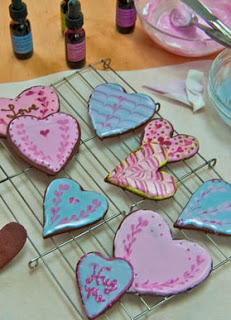
After researching lipstick dyes and various related allergies, I eventually decided to limit not just red synthetic colorants, but all the government approved FD & C (Food, Drug & Cosmetic Act) food dyes, including the familiar little 4-bottle food color sets stocked in grocery stores for home bakers.
Typically, these sets include mixtures containing FD&C red 40, red 3, yellow 5 (aka tartrazine), and blue 1: All of these are synthetic petrochemical colorants , and all have shown at least some evidence of being irritants or allergens in certain people. Red 40 and the particularly troubling tartrazine (both in a chemical class called azo dyes) are often considered the most suspect and have been banned from use in foods in some countries.
Initially, I began substituting the colors readily available in the form of fruit juices from the supermarkets. In many cases, these produce not only a beautiful look, but they contribute appealing flavor to frostings and icings. Cranberry juice and orange juice have been particularly handy; check out my buttercream frosting recipe here and my “painted daisies” sugar cookies here.
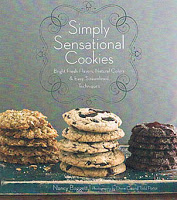 As you can see from the Valentine’s cookies, the results from these dyes can be very pretty, and they will likely satisfy all but the most finicky home pastry decorator. Note that while the Valentine’s cookies here feature pastels, you can also purchase holiday red and green and even botanically based sprinkles from Chocolate Craft Colors as are shown in the photo below and in more photos in the post here.
As you can see from the Valentine’s cookies, the results from these dyes can be very pretty, and they will likely satisfy all but the most finicky home pastry decorator. Note that while the Valentine’s cookies here feature pastels, you can also purchase holiday red and green and even botanically based sprinkles from Chocolate Craft Colors as are shown in the photo below and in more photos in the post here.
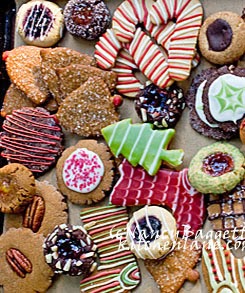 If you’re interested in how to create designs featuring little hearts like those shown in the romantic shot above, the step-by-step pics and directions are here.) Incidentally, my Simply Sensational Cookies book–which makes a fine holiday gift– features all kinds of “au naturel” decorating ideas. Watch a quick fun demo video, or see my Pinterest board featuring pictures from it here.
If you’re interested in how to create designs featuring little hearts like those shown in the romantic shot above, the step-by-step pics and directions are here.) Incidentally, my Simply Sensational Cookies book–which makes a fine holiday gift– features all kinds of “au naturel” decorating ideas. Watch a quick fun demo video, or see my Pinterest board featuring pictures from it here.
Another is simply see what happens when you add lemon juice to a small amount of tinted frosting —sometimes the shade is beautiful, not to mention totally unique. For example, the blue icing shown at far left in the pic turns pink (shown right), while the purple (back left) turns a slightly brighter, pink-orange shade (back right).
 I’m thrilled to have shifted to “naturally beautiful” decorating. It means I can enjoy cookie baking and decorating with my grandchildren and serve up eye-catching baked goods to my family without wondering about potential risks.
I’m thrilled to have shifted to “naturally beautiful” decorating. It means I can enjoy cookie baking and decorating with my grandchildren and serve up eye-catching baked goods to my family without wondering about potential risks.
If you are using botanical dyes make piped or “marbled” cookies, you need to use an icing that includes dried egg white powder or meringue powder, like the recipe here. It will help set these more fragile colors and keep them from fading, blurring together, and becoming splotchy during storage. Egg white powder is
sometimes stocked in the baking section of supermarkets; meringue powder is often found with Wilton
baking/cake decorating supplies in discount department and craft stores.
Don’t omit the corn syrup from the recipe, as it increases spreadability and
enables the icing to flow more smoothly and evenly. If you
prefer to avoid high-fructose corn syrup, use the Karo brand, which is
free of high-fructose corn syrup.
Tip: Be sure never to replace the
water called for with lemon or orange juice or any other other acidic
ingredients. Even small amounts will react with the pigments in the
natural dyes and cause their colors to change or fade in unpredictable
ways.
or 3 cups powdered sugar, if lumpy sift after measuring
powder
and egg white powder or meringue powder. Add the
corn syrup, vanilla (or other extract), and 4 1/2 tablespoons water. Stir
them in, gradually adding
more water as necessary for the desired consistency. For piping, the
consistency should be stiff enough that the icing holds its shape but
can be piped through pastry tips. For spreading, the icing should have a
fluid but not runny consistency. Divide
the icing among up to 5 or 6 smaller bowls for cookie icings and stir
in food colors as desired. Keep covered with plastic wrap when not being
used so they don’t dry out.
Use immediately or store them in the refrigerator for up to 4 or 5 days. Stir well and bring to room temperature before using.
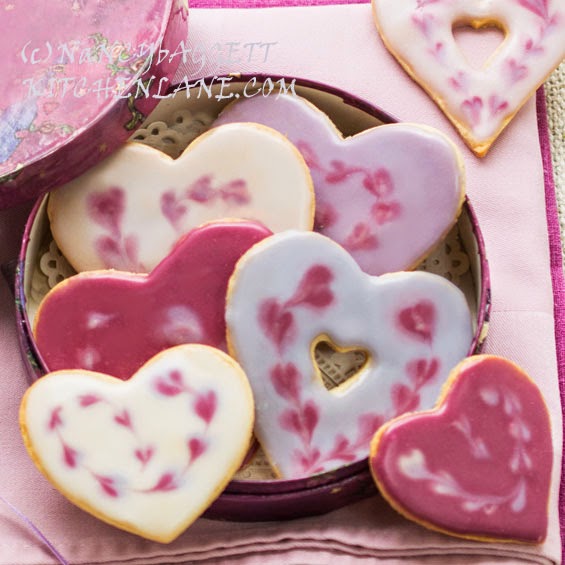
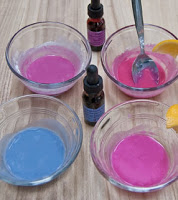
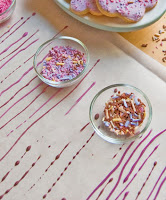


Thank-you for this review. I'm about to attempt a cake for a friend that must have gluten-free food, and wanted to avoid not only petroleum based dyes, but need gluten-free ones as well. Now I know what to buy!
You'll find the how-to and pics on creating the geometric look at:
http://goo.gl/ErWJG
Some of the cookies have designs that aren't hearts. You say how you made the little hearts, but how did you get the other designs that look like they are weaved?
I am so glad that you researched this and posted about it! After I would give my then 3-year old Goldfish crackers, he would be completely bouncing off the walls and irritable, unlike when I'd give him all natural things like fruit or a homemade cookie. I wondered if it might have been whatever coloring was in there causing his reaction. I have been looking for coloring alternatives, and am happy to know of a vendor, and impressed to see the beautiful results in the form of your lovely cookies!
Thanks, Melanie, glad to know you find it useful. I've been experimenting and learning about the topic for quite a long time.
Wow. What a post. Beautiful pictures, great skill, sound information, and, I know how much time it took to put it together and write it. I'm going to be revisiting this one and recommending it to many. Thank you.
The commercial botanical colors are easy to use and look very nice. I think they should work just fine for you. Good luck!
thank you for your post! I have not decorated any cookies with my kids because I did not want to use the artificial, petroleum based colors. I tried to make my own colors with juices but the results were not as bright. A while ago I added frozen rasperries puree to frost birthday cupcakes. Good to know that companies that make natural colors exist, I will try them out!